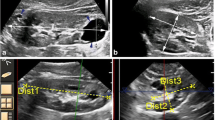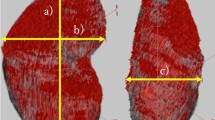Abstract
Objectives
To evaluate the accuracy of US in calculating renal volumes and renal resistive index (RRI) that was obtained using a new method in patients with autosomal dominant polycystic kidney disease (ADPKD).
Methods
In this prospective study, US and MRI were performed in 57 patients with ADPKD (31 female and 26 male; age range, 19–79 years) between August 2017 and May 2018. The volumes determined using US and MRI were compared. The ellipsoid formula was re-evaluated using different multipliers. RRI was obtained 1.5–2 cm distal to the outlet of main renal arteries. The relationship between mean RRI, renal function tests, and kidney volumes and difference between mean RRI of ADPKD patients with and without renal failure were investigated using a two-sided independent samples t test and Pearson correlation test. Interobserver agreements for volume assessments and RRI measurements were determined.
Results
By changing the ellipsoid formula, a very good agreement was found (ICC 0.970 for the right kidney and ICC 0.973 for the left kidney). The mean RRI in the right renal artery was 0.61 ± 0.07 and in the left renal artery 0.63 ± 0.06. The mean RRI of ADPKD patients with renal failure was significantly higher than that of patients without renal failure (p = 0.005). There was a significant correlation between mean RRI and renal function tests.
Conclusion
The accuracy of the US in calculating renal volumes increases by adapting the ellipsoid formula. RRI may be used for the management of ADPKD independently of volumes.
Key Points
•The accuracy of ultrasonography for renal volume measurement increases by changing the classical ellipsoid formula.
•Renal resistive index measured by color Doppler ultrasonography is helpful for the management of autosomal dominant polycystic kidney disease.
•The role of Doppler US in autosomal dominant polycystic kidney disease should increase as a result of our findings.




Similar content being viewed by others
Abbreviations
- ADPKD:
-
Autosomal dominant polycystic kidney disease
- AP:
-
Maximum anteroposterior distance
- BUN:
-
Blood urea nitrogen
- CCC:
-
Concordance correlation coefficient
- eGFR:
-
Estimated glomerular filtration rate
- H:
-
Maximum renal height
- ICC:
-
Intraclass correlation coefficient
- ML:
-
Maximum mediolateral distance
- MRI:
-
Magnetic resonance imaging
- RRI:
-
Renal resistive index
- TKV:
-
Total kidney volume
- US:
-
Ultrasound
References
Torres VE, Harris PC, Pirson Y (2007) Autosomal dominant polycystic kidney disease. Lancet 369:1287–1301
Sung CK, Kim SH, Ahn C (2008) Grayscale and Doppler ultrasonographic findings reflecting disease severity in autosomal dominant polycystic kidney disease. J Med Ultrasound 16:65–73
Pei Y, Obaji J, Dupuis A et al (2009) Unified criteria for ultrasonographic diagnosis of ADPKD. J Am Soc Nephrol 20:205–212
Nicolau C, Torra R, Badena C et al (1999) Autosomal dominant polycystic kidney disease types 1 and 2: assessment of US sensitivity for diagnosis. Radiology 213:273–276
Demetriou K, Tziakouri C, Anninou K et al (2000) Autosomal dominant polycystic kidney disease-type 2. Ultrasound, genetic and clinical correlations. Nephrol Dial Transplant 15:205–211
Grantham JJ, Torres VE, Chapman AB et al (2006) Volume progression in polycystic kidney disease. N Engl J Med 354:2122–2130
Food and Drug Administration (2016) Qualification of Biomarker-Total Kidney Volume in Studies for Treatment of Autosomal Dominant Polycystic Kidney Disease: Guidance for Industry. Food and Drug Administration, Silver Spring. Available via http://www.fda.gov/downloads/Drugs/Guidances/UCM458483.pdf. Accessed 6 Dec 2018
European Medicines Agency (2015) Draft Qualification Opinion-Total Kidney Volume as a Prognostic Biomarker for Use in Clinical Trials Evaluating Patients with Autosomal Dominant Polycystic Kidney Disease. European Medicines Agency, London Available via http://www.ema.europa.eu/docs/en_GB/document_library/Regulatory_and_procedural_guideline/2015/07/WC500190205.pdf. Accessed 6 Dec 2018
Platt JF, Ellis JH, Rubin JM, DiPietro MA, Sedman AB (1990) Intrarenal arterial Doppler sonography in patients with non-obstructive renal disease: correlation of resistive index with biopsy finding. AJR Am J Roentgenol 154:1223–1227
Patriquin HB, O’Regan S, Robitaille P, Paltiel H (1989) Hemolytic–uremic syndrome: intrarenal arterial Doppler patterns as a useful guide to therapy. Radiology 172:625–628
Kim SH, Kim WH, Choi BI, Kim CW (1992) Duplex Doppler US in patients with medical renal disease: resistive index vs serum creatinine level. Clin Radiol 45:85–87
Chapman AB, Johnson A, Gabow PA et al (1990) The renin angiotensin-aldosterone system and autosomal dominant polycystic kidney disease. N Engl J Med 323:1091–1096
Sawicki M, Walecka A, Rozanski J, Safranow K, Ciechanowski K (2009) Doppler sonography measurements of renal vascular resistance in autosomal-dominant polycystic kidney disease. Med Sci Monit 15:101–104
Bae KT, Tao C, Wang J et al (2013) Consortium for Radiologic Imaging Studies of Polycystic Kidney Disease (CRISP). Novel approach to estimate kidney and cyst volumes using mid-slice magnetic resonance images in polycystic kidney disease. Am J Nephrol 38:333–341
Bakker J, Olree M, Kaatee R, De Lange EE, Beek FJA (1997) In vitro measurement of kidney size: comparison of ultrasonography and MRI. Ultrasound Med Biol 24:683–688
Bakker J, Olree M, Kaatee R et al (1999) Renal volume measurements: accuracy and repeatability of US compared with that of MR imaging. Radiology 211:623–628
O’Neill WC, Robbin ML, Bae KT et al (2005) Sonographic assessment of the severity and progression of autosomal dominant polycystic kidney disease: the Consortium of Renal Imaging Studies in Polycystic Kidney Disease (CRISP). Am J Kidney Dis 46:1058–1064
Hammoud S, Tissier AM, Elie C et al (2015) Ultrasonographic renal volume measurements in early autosomal dominant polycystic disease: comparison with CT-scan renal volume calculations. Diagn Interv Imaging 96:65–71
Edell SL, Kurtz AB, Rifkin MD (1990) Normal renal ultrasound measurements. In: Goldberg BB, Kurtz AB (eds) Atlas of ultrasound measurements. Mosby- Year Book Chigago
Kim HC, Yang DM, Lee SH, Cho YD (2008) Usefulness of renal volume measurements obtained by a 3-dimensional sonographic transducer with matrix electronic arrays. J Ultrasound Med 27:1673–1681
Kim HC, Yang DM, Jin W, Lee SH (2010) Relation between total renal volume and renal function: usefulness of 3D sonographic measurements with a matrix array transducer. AJR Am J Roentgenol 194:W186–W192
Riccabona M, Fritz GA, Schöllnast H, Schwarz T, Deutschmann MJ, Mache CJ (2005) Hydronephrotic kidney: pediatric three-dimensional US for relative renal size assessment—initial experience. Radiology 236:276–283
Brancaforte A, Serantoni S, Silva Barbosa F, Di Leo G, Sardanelli F, Cornalba GP (2011) Renal volume assessment with 3D ultrasound. Radiol Med 116:1095–1104
Breysem L, De Rechter S, De Keyzer F et al (2018) 3DUS as an alternative to MRI for measuring renal volume in children with autosomal dominant polycystic kidney disease. Pediatr Nephrol 33:827–835
Kelcz F, Pozniak MA, Pirsch JD, Oberly TD (1990) Pyramidal appearance and resistive index: insensitive and nonspecific sonographic indicators of renal transplant rejection. AJR Am J Roentgenol 155:531–535
Chen P, Maklad N, Redwine M (1998) Color and power Doppler imaging of the kidneys. World J Urol 16:41–45
Afsar B, Elsurer R (2017) Increased renal resistive index in type 2 diabetes: clinical relevance, mechanisms and future directions. Diabetes Metab Syndr 11:291–296
Hanamura K, Tojo A, Kinugasa S, Asaba K, Fujita T (2012) The resistive index is a marker of renal function, pathology, prognosis, and responsiveness to steroid therapy in chronic kidney disease patients. Int J Nephrol 2012:139565
Parolini C, Noce A, Staffolani E, Giarrizzo GF, Costanzi S, Splendiani G (2009) Renal resistive index and long-term outcome in chronic nephropathies. Radiology 252:888–896
Brkljacic B, Sabljar-Matovinovic M, Putarek K, Soldo D, Morovic-Vergles J, Hauser M (1997) Renal vascular resistance in autosomal dominant polycystic kidney disease. Evaluation with color Doppler ultrasound. Acta Radiol 38:840–846
Kondo A, Akakura K, Ito H (2001) Assessment of renal function with color Doppler ultrasound in autosomal dominant polycystic kidney disease. Int J Urol 8:95–98
Parfrey PS, Bear JC, Morgan J et al (1990) The diagnosis and prognosis of autosomal dominant polycystic kidney disease. N Engl J Med 323:1086–1090
Gabow PA, Schrier RW (1989) Pathophysiology of adult polycystic kidney disease. Adv Nephrol 18:19–32
King BF, Torres VE, Brummer ME et al (2003) Magnetic resonance measurements of renal blood flow as a marker of disease severity in autosomal dominant polycystic kidney disease. Kidney Int 64:2214–2221
Funding
The authors state that this work has not received any funding.
Author information
Authors and Affiliations
Corresponding author
Ethics declarations
Guarantor
The scientific guarantor of this publication is Hakan İmamoğlu.
Conflict of interest
The authors of this manuscript declare no relationships with any companies whose products or services may be related to the subject matter of the article.
Statistics and biometry
Two of the authors have significant statistical expertise.
Informed consent
Written informed consent was obtained from all subjects (patients) in this study.
Ethical approval
Institutional Review Board approval was obtained.
Methodology
• prospective
• diagnostic or prognostic study
• performed at one institution
Additional information
Publisher’s note
Springer Nature remains neutral with regard to jurisdictional claims in published maps and institutional affiliations.
Rights and permissions
About this article
Cite this article
İmamoğlu, H., Zararsız, G., Doğan, S. et al. Autosomal dominant polycystic kidney disease: new role for ultrasound. Eur Radiol 29, 5991–5998 (2019). https://doi.org/10.1007/s00330-019-06238-0
Received:
Revised:
Accepted:
Published:
Issue Date:
DOI: https://doi.org/10.1007/s00330-019-06238-0




